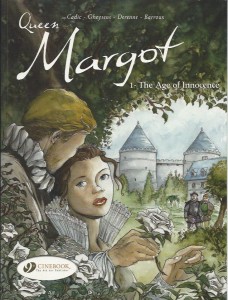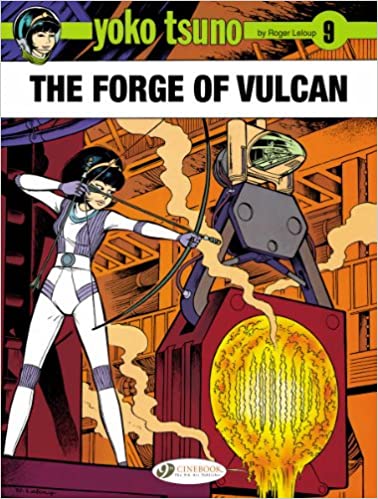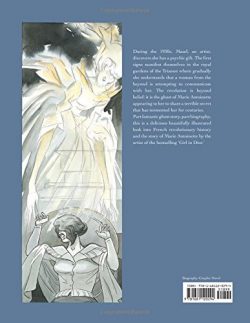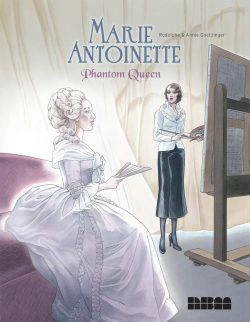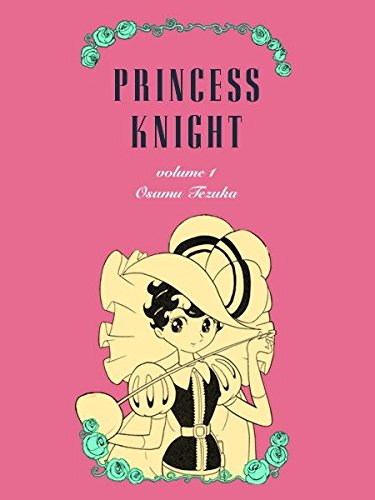
By Osamu Tezuka, translated by Maya Rosewood (Vertical)
ISBN: 978-1-935654-25-4 (PB)
Osamu Tezuka revolutionised the Japanese comics industry during the 1950s and 1960s. A devoted fan of the films of Walt Disney, he performed similar sterling service in the country’s fledgling animation industry.
Many of his earliest works were aimed at children, but right from the start his expansive fairy tale stylisations – so perfectly seen in this splendid romp – harboured more mature themes and held hidden treasures for older readers…
Ribon no Kishi or “Knight of the Ribbon†is a series which Tezuka returned to repeatedly during his life and one continued in the 21st century by his disciples. The simple tale has been turned into TV anime seen all over the world (generally known as some variation of “Choppy and the Princessâ€) and in 2006 became a stage musical.
The serial originated in Kodansha’s Shoujo Korabu (ShÅjo Club), running from January 1954 to January 1956, with a generational sequel appearing in Nakayoshi magazine from January 1958 to June 1959. The original tale was updated and revised in 1963-1966, forming the basis of the version in this magnificent tome, translated from the Tezuka Osamu Manga Zenshu Edition 1977.
In 1967-1968, to tie-in with a television adaptation, Tezuka reconfigured the tale with science fiction overtones. Limned by Kitano Hideaki, it ran for a year in ShÅjo Friend.
The series is a perennial favourite and classic of the medium and this volume is part of a 2-volume softcover (or digital) English-language edition, containing the first 16 episodes in vibrant monochrome.
‘Once Upon a Time’ opens in Heaven where junior angels are busy with soon-to-be-born souls, installing either blue boy hearts or pink girl hearts to the ante-natal cherubs in their care. Unfortunately, easily distractible Tink (AKA “Choppy†in many foreign iterations) cocks up and one proto-baby gets both…
Tink is dispatched to Earth to retrieve the superfluous metaphysical organ and lands in the feudal kingdom of Silverland, where a most important child is about to be born. The King and Queen desperately desire their imminent first-born be a boy, for no female can rule the country. Should the child be a princess, then vile Duke Duralumin‘s idiot and nastily maladjusted boy Plastic will become heir-apparent.
Thus, due to a concatenation of circumstances, a baby girl with a dual nature spends her formative years pretending to be a prince…
Fifteen years pass before ‘Flowers and Parades’ resumes the saga. Tink has been lax in his mission and Prince Sapphirehas become the darling boy of the kingdom. Duralumin and crafty henchman Sir Nylon have spent the intervening years certain the gallant boy is actually a useless girl, but have been unable to prove it. In that time, Sapphire has grown into a dutiful, beautiful – if androgynous – specimen skilled in riding, sports and all arts martial, but passionately yearns to openly wear the dresses and make-up which are her family’s most intimate secret. When Tink finally reveals himself and exposes the heir’s hidden nature, Nylon overhears…
‘The Carnival’ sees gorgeous Prince Franz Charming pay a royal visit from neighbouring Goldland. Sapphire, aided by her mother and nurse, dons a blonde wig and party frock to clandestinely give vent to her true nature, turning all heads and captivating her regal guest. When she returns to her public identity, all Franz can talk about is the mysterious girl with flaxen hair, blind to the fact that she is sitting beside him…
In ‘The Tournament’, the evil Duke turns a fencing exhibition to his advantage, killing the King and framing Franz for the deed, after which the ‘Prisoner Prince’ is helped to escape by his Flaxen maid. Heir Sapphire accedes to the throne in ‘Coronation’, only to have it all snatched away as the Duke’s latest scheme succeeds beyond all his wildest dreams. Sapphire is publicly exposed as a girl, and her recently widowed mother is accused of betraying the nation by concealing the fact…
Reviled and shunned, mother and daughter are imprisoned with ghastly hunchback jailer Gammer in ‘Sapphire in Coffin Tower’, wherein the distraught girl befriends the vermin of the Keep just as Gammer gets his orders to dispose of his charges. Meanwhile, Tink has been searching high and low for Sapphire…
Narrowly escaping being murdered, the princess becomes a masculine masked avenger of wrongs in ‘Phantom Knight’s Debut’, punishing the wicked men who have ruined her nation since Plastic was enthroned by Duralumin.
In the Palace, the villains look for ways to control the increasingly off-kilter Plastic in ‘The Idiot King’s Bride’. Little do they know that Briar Rose, the fetching companion they’ve acquired, is Sapphire, on an infiltration mission…
When she is inevitably caught, Sapphire’s life takes an even more dramatic turn in ‘Devil’s Whisper’ when terrifying witch Madame Hell materialises, offering her untold wealth and power if she will sell her female heart and nature. Luckily Tink’s angelic power drives the horror off, but is unable to prevent the princess being sentenced to a life of penal servitude in ‘Two by the Quarry’.
Here she again meets Franz, who has long believed Sapphire responsible for his frame-up and imprisonment in Silverland’s dungeons. Nevertheless, the Prince helps Sapphire escape, almost dying in the effort. Soon after the girl is transported to ‘The Witch’s Lair’ and meets Hell’s daughter Hecate, who violently opposes her mother’s scheme to marry her off to Franz. That young worthy, however, has meanwhile recovered from his wounds and is still searching for the flaxen-haired girl, oblivious to her true identity and nature…
Hecate does not want Sapphire’s girlish heart and frees the Princess Knight by turning her into a ‘Grieving Swan’ who is captured by Franz and added to the Royal Flock. The Prince too is being pressured to marry and beget an heir, so when Madame Hell arrives with a huge bribe and a now compliant Hecate the boy’s uncle is keen to cement the nuptial alliance until the ensorcelled swan Sapphire exposes their true natures with Tink’s angelic assistance…
Just as Franz begins to finally notice the similarity of his flaxen dream girl to the freshly restored Sapphire in ‘Two Hearts’ she and Tink are fleeing – right into the clutches of Nylon who is keen to wipe out any loose ends. At the worst possible moment, the angel completes his long mission and reclaims the boy-heart, leaving her helpless, but cannot betray his friend and returns it, consequently losing his place in Heaven…
Together again the pair attempt to rescue Sapphire’s mother from Coffin Tower but are too late. The Queen and Gammer have been taken to Sea Snake Island where vengeful Madame Hell’s dark magic has transformed her into a petrified ‘Stone Queen’.
The drama pauses with Sapphire and Tink adrift on the ocean and encountering brilliant, dashing, gloriously charismatic ‘Captain Blood, Pirate’ who instantly penetrates the princess’ manly disguise, seeing a woman he must marry at all costs…
Princess Knight is a spectacular, riotous, rollicking adventuresome fairy tale about desire, destiny and determination which practically invented the Shoujo (“Little Female†or young girl’s manga) genre in Japan and can still deliver a powerful punch and wide-eyed wonder on a variety of intellectual levels. Still one of the best and most challenging kid’s comics tales ever, it’s a work that all fans and – especially parents – should know.
© 2011 by Tezuka Productions. Translation © 2011 by Mari Morimoto and Vertical, Inc. All rights reserved.



